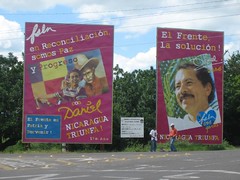Wednesday, October 11, 2006
Elections in Nicaragua: Two Contrasting Paths to Choose
Hola Gente,
We're less than a month away from the presidential elections of Nicaragua, yet it seem that the voting is taking place tomorrow: the whole country is flooded with unregulated expensive political advertising (see the picture), the parties' caravans are seem everywhere making traffic worse, and politics is in everybody's conversations regardless of where you are. Since my arrival to Nicaragua, people tell me that these are the most decisive elections in recent history. And they are definitely right.
So without forgetting our topic agriculture, let’s talk about politics for a bit as they have a direct effect on the welfare of the rural sector and the fate of agriculture (check out this post). Since the end of the Sandinista Revolution in 1989, Nicaragua has seen bipolar election campaigns: you voted for the Sandinistas or against the Sandinistas. The Sandinistas, always represented by Daniel Ortega in the FSLN party lost to; Violeta Chamorro (1990), to Arnoldo Aleman (1997) and to Enrique Bolanos (2002). Until then, the run for president was solved easily because the Sandinistas haven't been able (since 1990's) to get more than 35% of the popular vote.
This changed drastically when Aleman signed "el Pacto" (a political pact) with the Sandinistas in which some key political figures of the FSLN got permanent government positions and other political favors. This pact improved the condition of the FSLN and in return Aleman received lax treatment when his corruption charges surfaced the public. The spillover effect, however, was a strong division in the two parties which saw the pact as ideologically incongruous and driven by personal ambitions of Aleman and Ortega. The results were the following: liberals against the pact (ALN) and for the pact (PLC), and Sandinitas against the pact (MRS) and for the pact (FSLN).
Now according to polls, the Daniel Ortega (FSLN) leads with 30% of the vote, followed by Eduardo Montealegre (ALN) with 25%, Mundo Jarquin (MRS) with 15%, and Jose Rizo (PLC) 10%. Because this distribution has never taken place in the recent history of Nicaraguan, there is an overwhelming sense of uncertainty that maintains the country on a frustrating status quo. Besides the unique campaign distribution, there has also never been a runoff election in Nicaragua before, and the amount of people expected to vote appears to be unprecedented, raising questions about logistics and transparency.
What is best for the country? You may ask. This is, of course, up to the Nicaraguans to decide. That is not to say, however, that the outcome of this election will have a direct effect in Central America and possibly in the whole continent. In my opinion, Nicaraguans have to choose between a prosperity path that guarantees economic, political, and social freedom, and an already traveled path of isolation, injustices, and poverty. Although these may sound like plain broad words, I believe the voting decision of the Nicaraguans boils-down to these two paths.
The former path is represented by both Montealgre and Jarquin. Montealegre, who I had the opportunity to speak with, will ensure economic prosperity with a broad growth agenda. Jarquin, also an economist, promises sustain growth and social equity. In my opinion, Nicaraguans must be practical a vote for Montealegre as he is the one with the highest chances of winning. This election is too important to take the risk of voting for a candidate with a slight chance of winning, and only Montealegre ensures a strong vote.
Looking at my notes on Montealgre's presentation at George Washington University in Washington DC (06/15/2006), I find a candidate prepare to run the country in the right direction. Putting emphasis on transparency, economic growth, government institutions, education, and health, he has the silent support of most governments in the region (U.S support for him is controversially quite noisy). When asked about agriculture, he talked about the importance of both creating new markets for export commodities, and assisting small farmers with technical, commercial, and financial help. With an almost nonexistent local market for agricultural output in Nicaragua and with the new set of trade agreements, focusing in exports is a wise policy.
From the time when Violeta Chamorro defeated the face of the revolution in the 1990’s presidential election, Nicaragua has traveled a bumpy road similar to the thousands that lead to the rural areas. Yet, the momentum gain until now is priceless as it has built the foundations for strong growth and stability. I hope this stability is not shaken by the usual earthquakes, not geological but political, that affect the country so often. Daniel Ortega remains an enormous threat to the future and prosperity of the country and must be defeated once for all.
I finish the post providing a link to an interesting article published by the Washintopost.com. The author Roger F. Noriega from the American Enterprise Institute (conservative think tank) talks about the possible scenarios for Nicaragua in this election. Click HERE the read the article.
Subscribe to:
Post Comments (Atom)


No comments:
Post a Comment